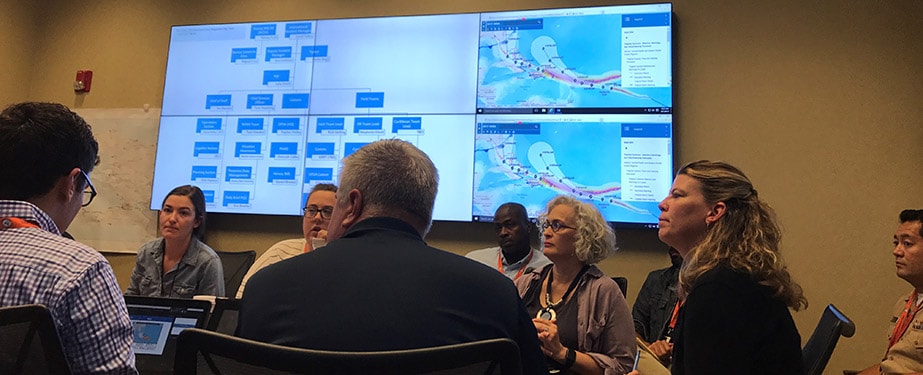Hurricane Season 2017: Emergency Responders at the Ready
February 28, 2018

International Task Force conducting a meeting concerning Hurricane Irma (2017).
Public Health Threat:
Natural disasters like hurricanes can leave people vulnerable to a multitude of risks, including diseases. When the unthinkable happens, people may not have access to medical care or clean water. Normal routines are disrupted, and crowded living conditions provide fertile ground for diseases to spread.
The 2017 Atlantic hurricane season was particularly active and destructive. On September 6 – not long after Hurricane Harvey ravaged the United States – Hurricane Irma hit the Leeward Caribbean islands as a Category 5 storm. The powerful storm damaged or destroyed 95 percent of Barbuda’s buildings before heading toward Hispaniola and eventually reaching the southeastern coast of the United States.
Response:
By September 5, CDC’s emergency response and recovery experts had already begun preparing for Irma’s international landfall. They stood up an Incident Management System (IMS), which is an internationally recognized system used to coordinate emergency responses. Two days later, when CDC’s Emergency Operations Center activated for the domestic and international Hurricane Irma response, the existing IMS plugged into the agency-wide activation as the International Task Force (ITF).
Having managed the extensive Hurricane Matthew response in 2016, the CDC Haiti country office was ready. They initiated early conversations with CDC headquarters to identify and plan for potential needs. On September 8, CDC Haiti officially requested assistance. In response, the ITF sent a geographic information systems (GIS) specialist to assist Haiti with mapping hurricane-affected water systems. The GIS specialist created maps and engineering documents for 30 water systems, five of which Hurricane Irma had damaged. Haiti’s National Directorate of Potable Water and Sanitation used the maps to advocate for emergency financing to repair the damaged systems. Logistics and health communications experts on the ITF provided additional response support from CDC headquarters to help maintain a smooth running response.
Impact:
Early and frequent communication between the CDC Haiti country office and emergency response experts at CDC Atlanta ensured that an efficient, coordinated response was in place. This hurricane season’s responses also strengthened interaction between CDC experts in domestic and international crises. After Irma, the ITF stood down – only to be reactivated when Hurricane Maria struck.
In addition to offering expertise in all critical areas of emergency response including health; nutrition; infectious diseases; mental health; reproductive health; risk communications and community engagement; surveillance; coordination; logistics; and water, sanitation and hygiene, CDC’s Emergency Response and Recovery Branch also coordinates the Global Rapid Response Team (Global RRT).
The Global RRT is a unique resource that can rapidly respond to global public health concerns. The Global RRT responds to emergencies when and where they occur to stop health threats before they reach our shores.